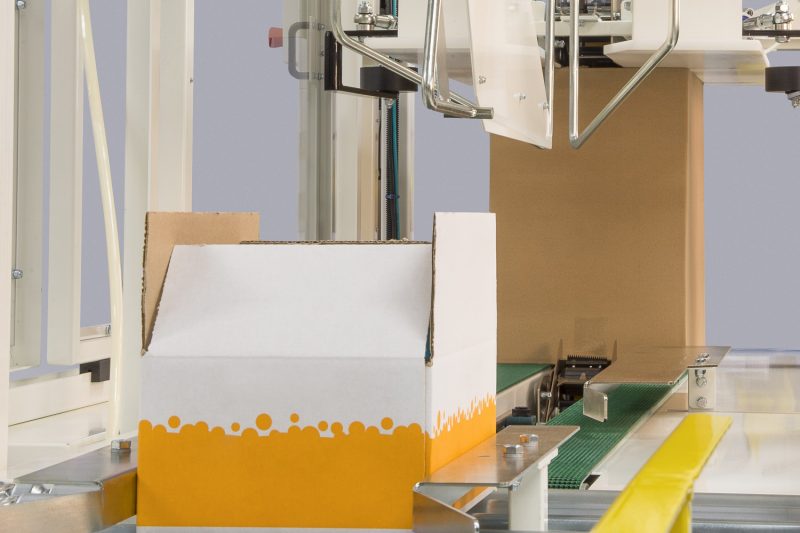End of line engineering

The confectionery industry is characterised by short runs and small batch production, particularly during seasonal events such as Easter and Christmas. Consequently, confectionery packaging has traditionally been accomplished manually. However, in the face of a UK living wage, coupled with the growth of affordable systems, suppliers and manufacturers of confectionery ingredients – from icing sugar to chocolate bars – are increasingly automating their packing facilities to enhance their competitive edge.
While 2016 has been a ‘tipping point’ for manufacturing technology, with increasing numbers of companies embracing robotics and automation, Industry 4.0 and the need for intelligent systems will continue to advance throughout 2017. While this rise in the manufacturing sector has sparked employment debates, companies are realising the potential to improve output and efficiencies through automation. Job roles will start to shift away from labour intensive repetitive tasks to more intricate roles to optimise manufacturing processes and aid business development, and the confectionery industry is by no means immune to these changes.
As the consumption of confectionery products continues to rise, consumers do not just want their taste buds tickled – they want to be visually enticed by the packaging. Retailers are putting increasing pressure on confectionery manufacturers to not only be innovative with their packaging and shelf ready casing, but to offer a wider range of products than ever before. Existing products, with traditions going back years, are being supplemented by sugar-free or low-calorie options with additional products for the rising number of vegans and diets to counteract intolerances.
So, while automating an end of line packaging line within a confectionery factory would undoubtedly reduce the repetitiveness of manually erecting, packing and sealing cases and boosting output, the frequent changeovers due to the large product diversity is often seen as counterproductive.
Consequently, many confectionery producers question investing in automation in case the system becomes obsolete within a couple of years. Wrong. Any automation supplier worth their salt will offer an adaptable solution to future proof an investment. Today the intelligence of machines has vastly improved and many machines can be upgraded or retro-fitted with new technology to suit the changing demands from customers.
Increasingly flexible, end of line systems are engineered to run at higher speeds than ever before with quick, simple changeovers for different products. When purchasing automated systems, manufacturers need to factor in several machinery features to protect the longevity of their investment. In-built adjustment handles or LCD touch screens need to be accessible and offer ease of use to the manufacturer, while allowing for a quick changeover period. These should factor in a wide range of different case sizes and dimensions so no matter how frequently a retailer demands a change in box style, the confectionery manufacturer can easily reprogram their case erector or sealer.
There is also a rise in random case sealing machines which can not only run at high speeds, but automatically handle a wide range of different case sizes through bar code recognition.
These high specification systems not only fully automate the packing of several lines into one, but reduce the amount of floor space which several standard machines would take up.
Standing to attention
It’s a business solution developed to drive down supply chain costs and meet the needs and expectations of retailers – and the market for shelf ready packaging (SRP) is widespread among the confectionery market – thanks to retailers hungry for presentable products and simple stocking.
Back in 2012, Cadbury UK pledged £6 million ($7.6m) into introducing shelf ready packaging to ensure its sweet products were stood upright on the supermarket shelf – commanding the attention of consumers. The brand’s belief was that the more visible the bar the more likely it was to be purchased.
SRP offers a number of benefits – not least greater ease of access to the product, improved branding and in store efficiency, so retailers often see it as a must-have, and use their leverage with manufacturers to make it happen, but confectionery manufacturing is an ever changing industry, with the constant shift in consumer trends posing an ongoing challenge. To keep up, retailers frequently set new criteria to change the design of shelf ready cases – making products more accessible and attractive to consumers. However, the need to comply with these retail expectations and changing SRP criteria can prove to be either good or bad for confectionery manufacturers who are investing heavily in automated packing equipment.
With the global demand for SRP expected to reach 32.1m tonnes by 2017 [1], and in the face of the rising robotics and automation uptake, confectionery manufacturers need to ensure that the initial investment they make in automating their packing operation becomes a long-term asset with the ability to deal with SRP today, while providing the capacity to adapt as these demands continue to evolve over the years.
The quality of SRP cases can often come under fire as, if this is poor, the case can easily tear during the opening process and this can inflict costly penalties and unnecessary wastage. A case erector handling a variety of case materials and sizes can indeed cause tears if the case is not opened positively from both sides, however this can be overcome with the use of dual opposing vacuum technology which provide solid, equal compression to pull the case open securely, eliminating potential wastage.
For ease of construction many confectionery manufacturers traditionally utilised costly, tuck in bottom ‘crash lock’ cases. However, the most recent SRP criteria demands the design and performance of these cases offer more efficient handling and faster brand recognition to ensure easier product access. To this end the use of hot melt glue within case erectors is preferable as tape can interfere with the functionality and look of the cases at the retailer.
For most, if not all confectionery producers, the return on investment (ROI) figures can be a real problem. However, with careful planning, a 12-month ROI is attainable. A well thought out automated system can quickly turn an inefficient labour intensive operation into a cost effective high output production line.
There is no question that packaging requirements will continue to evolve, particularly within the confectionery market. Manufactures should look for modular systems to create a bespoke production line which can be easily reconfigured or retro-fitted with new technology to suit the changing demands placed on them. Automation shouldn’t be a throw away investment but one which can become a tangible asset for many years.



